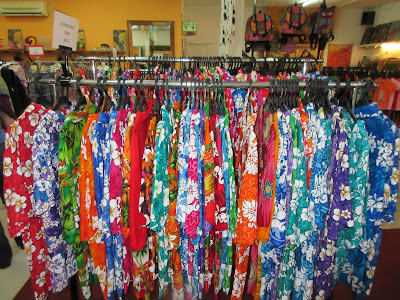My last foray in Kuala Lumpur, Malaysia for this trip was a great tour found by my husband and it included a trip to a store where they make batiks to learn about the process!
 |
| Some batiks painted on paper displayed in the shop |
I had lessons on batik in high school, but it was on paper instead of fabric and I was curious to see if it was the same process.
I was greeted by sights of these lovely batiks immediately. Imagine my surprise when they didn't look anything like the ones you purchase in the stores most places!
 |
| Hand painted batiks...and the wax is still inconspicuously on both! |
The Malays, as it turns out, took batiks and made them their own. You won't see anything that resembles the types of batik you are used to here unless it's been imported.
The Indonesians typically create prints by hand dyeing, machine work, or the low quality batiks are only printed on one side. The guide advised if we see a batik material that is not the same on both sides it is very low quality.
The Indonesians also usually use what the Malays call a "block print," which means it has what we in the quilting world call a repeat.
 |
| Block print (Indonesian) vs. Sketching the print, which is typically more Malay |
 |
| They call laying the wax Canting, and painting of the batik Coloring |
Here are some photos detailing how the process usually works:
Typically you'd start by dyeing your fabric to begin with - that color is the color that will show through once you remove the wax. So if I wanted my designs on the material to show in yellow, I would dye it yellow first.
Once it dries, it's time to sketch and then lay down your design in wax. The wax is layered on thick enough to sit on top of the material for later removal.
Then, as pictured below, you'd dye it in the color you want to show most. So if you look at the first photo in the post, that's a mint green.
Then you leave it to dry, and would likely use color setting methods after this.
But that's how most places do it. In Malaysia, the Malays do it ALL by hand. And they start with a blank piece of silk.
The Malays create silk batiks and their process begins by drawing the wax on by hand.
Their wax is put on more thinly and it's designed to mesh in with the material, creating a barrier all the way through the fabric instead of sitting on top to be removed later.
Unlike your typical store-bought batiks though, they also don't waterproof these. They recommend having them laminated or sealed in some way and then framing them.
These are usually created as strictly art pieces.
Our guide here is demonstrating how he creates batiks.
This particular artist is so confident he never sketches by hand first but instead goes straight in with the wax...how brave!
He was then generous enough to trust me with a batik he later intends to sell!
I held my breath and tried not to screw up his art!
Unlike the Indonesians, they don't seem to have a color/technique specialty by province, and it's all interpretation based on the artist.
Look how pretty it is! This painter tends to use more earthy tones in his work, but Malays have a wide variety of interpretations and color sets.
I'm honored to know "my" work will be sold when he's finished 😄 Mine is the super awesome brown one in the center. Can you tell I'm born to batik? 😂
These are some of the tools they use in the laying of the wax.
These beauties are examples of the hand-painted batiks! I fell in love with the yellow and teal beauty in the center and had to have it!
Really, I'd have bought them all, but just like quilts are art, these are too...which means they had the price tag to match!
 |
| "Hawaiian" shirts. These are made with the low quality batik the guide mentioned. They are perfectly suitable for clothing, but not quilting! |
Here are a few more lovely examples of art I saw around the shop, all created by different local artists...
And last but not least, what I took home...
 |
| This one was by my guide...I like to think those red spots are someone else's original work as well 😉 |
 |
| My best purchase on the whole trip! This was just after I unrolled it. |
Well, that just about covers the fabric highlights of my trip to Kuala Lumpur.
It was really an honor to meet some artists, and even more of an honor when they thought my quilts were art too!
I think it's safe to say I won't be cutting these up as quilts, but I will be finding a way to waterproof them, as I don't really want to frame them. I like them hanging brilliant and free the way they were when I spotted them.
Did you know how they make batiks? Are you ready to jump on a plane after seeing their gorgeous hand-painting?













No comments:
Post a Comment